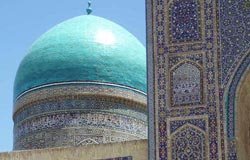 |
|
|||||||||||||||
|
|
||||||||||||||||
|
Uzbekistan is a land
scattered with some of the finest architectural jewels amongst the Silk
Road countries and has attracted some of the world’s greatest travellers,
and conquerors. From the West came Alexander the Great, from the East
came Tamerlane and Genghis Khan. While the country is young, having
gained independence in 1991 after the break-up of the Soviet Union, the
roots of Uzbekistan are ancient. The historic town of Samarkand, a major Silk Road crossroad and emporium, which was founded in 7BC as ancient Afrasiab, is regarded by many as the ‘Jewel of Islam’ and ‘the Pearl of the East’. Today it still boasts sparkling turquoise domes and towering minarets rich with intricate Islamic tile work, as well as many well preserved madrassas (Islamic schools) from the time when Central Asia was a centre of empire and learning. Good examples of this architecture can be found all over Uzbekistan. The ancient walled city of Khiva, the most preserved and remote of the Silk Road cities, is a living ‘museum city’ where a vast collection of Islamic architecture remains frozen in time (although zealously restored) within its bastioned city walls. Here, tourists and wedding parties can often outnumber locals, all drawn by its photogenic setting. Bukhara is probably the best of the ‘big three’. It has not been as rigorously restored as Khiva and the winding narrow streets of the old town in Bukhara city (where there is said to be a mosque for each day of the year) retain plenty of romance. Travel writers and historians all agree that Bukhara – the ‘Pillar of Religion’ and the ‘Dome of Islam’ – is one of the most interesting cities in the world. It is a place of mullahs and merchants which, fortunately, was not as sovietised as Samarkand, and therefore avoided the concrete grey tower blocks and monoliths which blight Samarkand’s cityscape. While the Soviets did sanitise and secularise Bukhara to some degree, by draining canals and converting mosques to offices, it has always managed to retain its eastern ambience. The Ferghana Valley, which is surrounded by the Tien Shan and Pamir mountains is the country's most fertile region and still produces silk. It is well worth visiting for its friendly bazaars and the landscape of mulberry trees and fruit orchards. Around 80% of the country is flat desert, but the mountain ranges that rise in the far southeast and northeast attract hikers, cyclists and backcountry skiers, while experienced mountaineers come to climb the 4,000m (13,000ft) peaks around the Tien Shan. Uzbekistan’s landscape is also home to one of the world’s worst ever natural disasters, the Aral Sea (a lake whose name refers to the thousands of islands that once spread across it). Once the world’s fourth-largest lake, it is now completely depleted after Soviet planners used the sea’s resources to irrigate cotton fields. This resulted in a destroyed ecology, climate and fishing industry. The resulting salt and dust sandstorms continue to blight the health of tens of thousands of people. Despite this disaster, and various other threats – namely a hardline government, corrupt officials and Islamic militants – the people of Uzbekistan remain genuinely hospitable to visitors, in itself, a prime attraction. |
|
||||||||||||||
|
|
||||||||||||||||
|
||||||||||||||||
|
|
||||||||||||||||
|
|
|
|
|
|||||||||||||
| Gardesh Tourism © 2010-2014 | ||||||||||||||||






